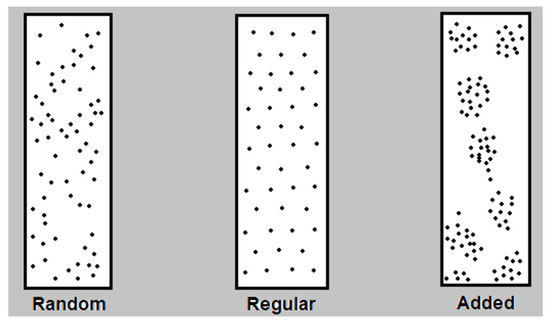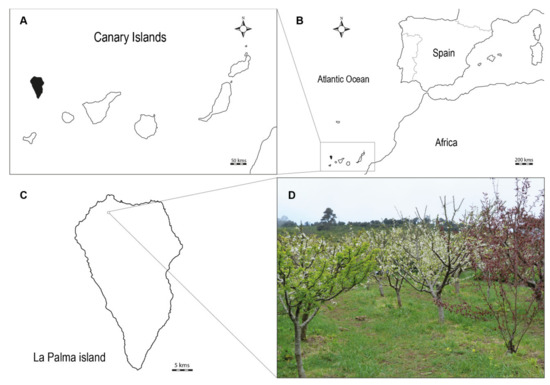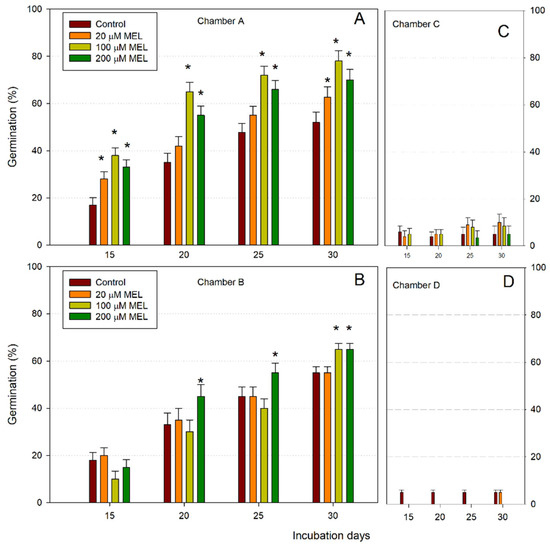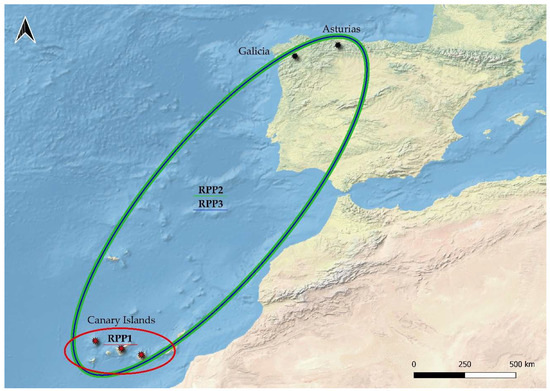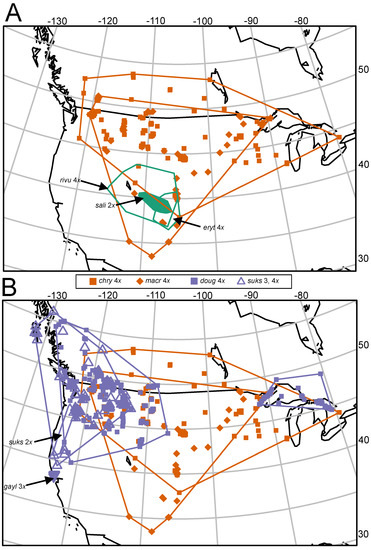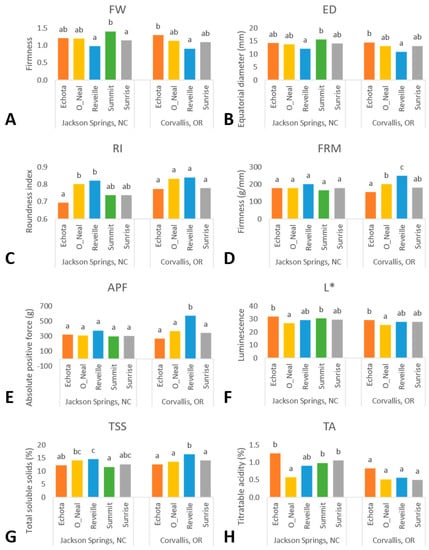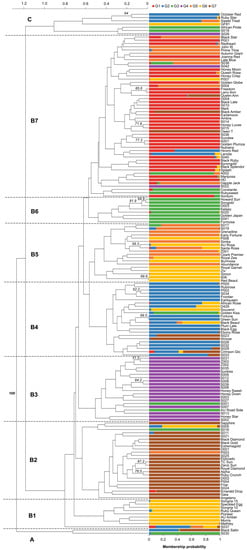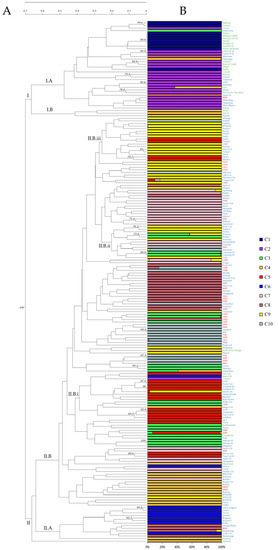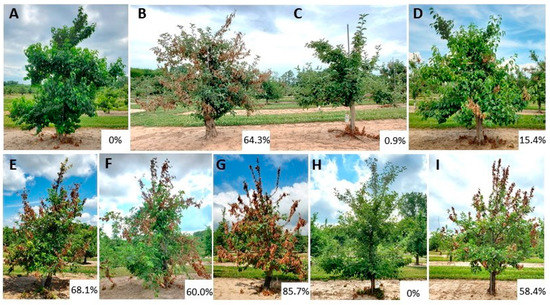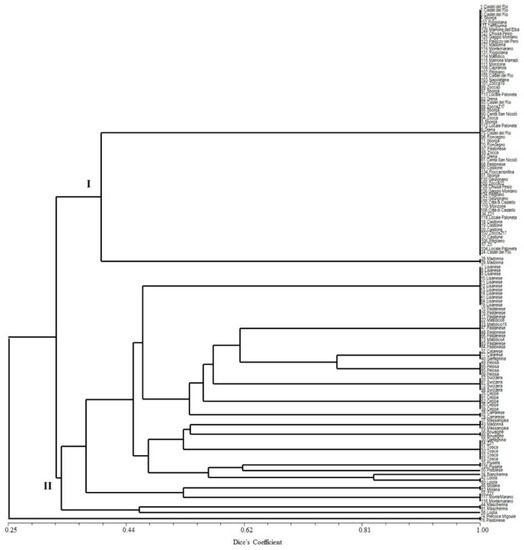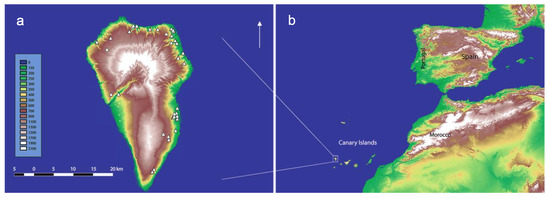Genetic Diversity Evaluation of the Fruit Trees
Share This Topical Collection
Editors
 Prof. Dr. Santiago Pereira-Lorenzo
Prof. Dr. Santiago Pereira-Lorenzo
 Prof. Dr. Santiago Pereira-Lorenzo
Prof. Dr. Santiago Pereira-Lorenzo
E-Mail
Website
Collection Editor
Department of Crop Production and Engineering Projects, Universidade de Santiago de Compostela, Campus de Lugo, 27002 Lugo, Spain
Interests: genetic resources; phenotypic and genotypic traits; selection and breeding; domestication; crop production; agronomy; biodiversity and conservation
Special Issues, Collections and Topics in MDPI journals
 Dr. José Iñaki Hormaza
Dr. José Iñaki Hormaza
 Dr. José Iñaki Hormaza
Dr. José Iñaki Hormaza
E-Mail
Website
Collection Editor
Subtropical Fruit Crops Department, Instituto de Hortofruticultura Subtropical y Mediterránea ‘la Mayora’, (IHSM la Mayora -CSIC-UMA), Algarrobo-Costa, 29750 Málaga, Spain
Interests: diversity in subtropical (cherimoya, avocado, mango, litchi, longan) and temperate fruit crops using molecular and phenotypic markers
Special Issues, Collections and Topics in MDPI journals
Topical Collection Information
Dear Colleagues,
Conservation and sustainable management of germplasm is the key for guaranteeing food security for future generations since this will determine the ability of crops to adapt to environmental changes. Significant advances in the application of molecular tools to analyze and conserve genetic diversity in annual and perennial crops have taken place in the last two decades. Although in most cases the new technologies are first developed in annual crops, some particularities of most fruit crops, such as their perennial nature, long generation times, large individual size, or vegetative propagation, make the advantages of using these new approaches even more relevant in these species.
This Topical Collection will focus on “Genetic Diversity Evaluation of the Fruit Trees”. We welcome novel research, reviews and opinion pieces covering all related topics including new approaches to analyze genetic diversity in fruit crops, in situ and ex situ germplasm conservation, the use of diversity in fruit crop breeding, phenotyping and genotyping diversity, biotechnological approaches to conserve germplasm, spatial diversity analyses and case-studies relevant for fruit crop germplasm conservation.
Genetic resources are linked to numerous research activities and methodologies. Therefore, we aim to publish original research and reviews that improve our understanding of the evaluation and use of the genetic resources of fruit tree species, particularly manuscripts that address the following topics:
1. Evaluation of phenotypic traits of fruit tree species, those related to the measurement of quantitative and qualitative traits, as well as the statistics applied to diversity descriptors.
2. Methodologies used in the evaluation of phenotypic and genotypic traits to determine taxonomic affinity (phylogenetics), identity, kinship relationships, bottlenecks, differentiation, lineages and in the definition and management of germplasm banks and core collections.
3. Statistics used in the evaluation of quantitative and qualitative traits and genetic diversity.
4. Regulations and policies related to protection of genetic resources and new cultivars, certification, international interchange exchange of genetic resources.
5. The use of genetic resources in the bioeconomy, landscape, Protected Denominations of Origin (PDO) and Protected Geographical Indications (PGI), natural and cultural heritage, including its role for biodiversity conservation, and the ethnographic values associated with traditional management practices.
6. Finally, case studies on woody trees related to forest and crop production such as chestnut, apple tree, pear tree, grape and others.
We invite our colleagues to submit contributions describing their advances that will surely improve the knowledge of genetic resources of fruit tree species.
Prof. Dr. Santiago Pereira-Lorenzo
Dr. José Iñaki Hormaza
Collection Editors
Manuscript Submission Information
Manuscripts should be submitted online at www.mdpi.com by registering and logging in to this website. Once you are registered, click here to go to the submission form. Manuscripts can be submitted until the deadline. All submissions that pass pre-check are peer-reviewed. Accepted papers will be published continuously in the journal (as soon as accepted) and will be listed together on the collection website. Research articles, review articles as well as short communications are invited. For planned papers, a title and short abstract (about 100 words) can be sent to the Editorial Office for announcement on this website.
Submitted manuscripts should not have been published previously, nor be under consideration for publication elsewhere (except conference proceedings papers). All manuscripts are thoroughly refereed through a single-blind peer-review process. A guide for authors and other relevant information for submission of manuscripts is available on the Instructions for Authors page. Agronomy is an international peer-reviewed open access monthly journal published by MDPI.
Please visit the Instructions for Authors page before submitting a manuscript.
The Article Processing Charge (APC) for publication in this open access journal is 2600 CHF (Swiss Francs).
Submitted papers should be well formatted and use good English. Authors may use MDPI's
English editing service prior to publication or during author revisions.
Keywords
- Genetic variation
- Phenotypic traits
- Fruit trees
- Evaluation
- Characterisation
- Genetic resources
- Germplasm bank
- Core collection
- Valorisation
Published Papers (13 papers)
Open AccessArticle
Natural and Artificial Occurrence, Structure, and Abundance of Juglans neotropica Diels in Southern Ecuador
by
Byron Palacios-Herrera, Santiago Pereira-Lorenzo and Darwin Pucha-Cofrep
Viewed by 746
Abstract
This study investigated the presence and characteristics of
Juglans neotropica in three ecosystems in Southern Ecuador: Montane Evergreen Forest, Evergreen Seasonal Lower Montane Forest, and Semideciduous Foot Montane Forest. The main focus was the species’ multipurpose nature as both a fruit and timber
[...] Read more.
This study investigated the presence and characteristics of
Juglans neotropica in three ecosystems in Southern Ecuador: Montane Evergreen Forest, Evergreen Seasonal Lower Montane Forest, and Semideciduous Foot Montane Forest. The main focus was the species’ multipurpose nature as both a fruit and timber source. Six study sites, totaling at least 0.5 hectares each, were established, with four in Loja province and two in Zamora Chinchipe province. The results showed significant differences in dendrometric variables across the sites, with the most favorable growth recorded in The Tundo, where trees exhibited an average diameter at breast height (DBH) of 45.16 cm, basal area (G) of 1.41 m
2, total height (TH) of 19.22 m, canopy height (CH) of 13 m, cubic volume (CV) of 3.55 m
3, and total volume (TV) of 5.22 m
3. The species displayed a clumped distribution pattern, as indicated by a Morisita index greater than 1. Regarding abundance, the highest density of 297 trees per hectare was found in Argelia, while Victoria had the lowest density of 46 trees per hectare. The research provides a better insight into the occurrence, forest structure characteristics, and distribution of
Juglans neotropica, an important multipurpose species, in Southern Ecuador.
Full article
►▼
Show Figures
Open AccessArticle
Genetic Characterization of a Plum Landrace Collection from La Palma, Canary Islands
by
Verónica Pérez, Javier Rodrigo, Donia Abdallah, Nerea Larranaga and José I. Hormaza
Cited by 1 | Viewed by 1399
Abstract
A plum collection located in the island of La Palma, Canary Islands, composed of twenty-nine European and Japanese plums was analyzed using nine simple sequence repeat (SSR) highly polymorphic loci. First, a cytometry flow analysis was performed to determine the ploidy level. Sixteen
[...] Read more.
A plum collection located in the island of La Palma, Canary Islands, composed of twenty-nine European and Japanese plums was analyzed using nine simple sequence repeat (SSR) highly polymorphic loci. First, a cytometry flow analysis was performed to determine the ploidy level. Sixteen accessions turned out diploid and thirteen hexaploid. According to morphological characteristics, fourteen of the sixteen diploid accessions were assigned to
Prunus salicina, and two accessions to
P. cerasifera. All the hexaploid accessions were assigned to
P. domestica. The 29 accessions were compared using SSR markers with twenty-two
P. domestica accessions maintained at the CITA plum germplasm collection located in Zaragoza, Aragón, Spain. A principal component analysis (PCA) and a clustering approach grouped the accessions according to the assigned species and geographical location, while some synonyms and homonyms were found within La Palma accessions. The two principal components explained 80.3% (67.3% and 13%, respectively) of the total variance. A tree generated with UPGMA hierarchical clustering and Bruvo distance grouped the accessions in two main clusters according to ploidy level and species assignment. The STRUCTURE approach clearly differentiated La Palma diploid accessions and some of the hexaploid accessions from those of the CITA collection. The results obtained could be used for management and conservation purposes of this valuable local plum germplasm.
Full article
►▼
Show Figures
Open AccessCommunication
Effects of Temperature and Light on the Germination-Promoting Activity by Melatonin in Almond Seeds without Stratification
by
Sara García-Sánchez, Antonio Cano, Josefa Hernández-Ruiz and Marino B. Arnao
Cited by 4 | Viewed by 1476
Abstract
Melatonin is a new plant hormone involved in multiple physiological functions in plants. Its roles in germination, photosynthesis, growth, flowering, fruiting, and senescence are noteworthy. Most studies have focused on its protective role in different stress situations, both biotic and abiotic. Preliminary data
[...] Read more.
Melatonin is a new plant hormone involved in multiple physiological functions in plants. Its roles in germination, photosynthesis, growth, flowering, fruiting, and senescence are noteworthy. Most studies have focused on its protective role in different stress situations, both biotic and abiotic. Preliminary data on its promoting role in almond seed germination and seedling growth are presented in this work. The germination-promoting capacity of melatonin was studied in different conditions of light and temperature, with important differences with respect to untreated seeds. The data confirmed that, at specific concentrations, melatonin was capable of stimulating germination, avoiding the stratification process, and therefore, shortening germination times. Furthermore, the melatonin-primed seedlings showed a higher root and aerial growth versus the untreated seeds when light was applied. The possible agronomic impact on the propagation of stone fruit trees was also discussed.
Full article
►▼
Show Figures
Open AccessEditor’s ChoiceArticle
Genetic Pool of the Cultivated Pear Tree (Pyrus spp.) in the Canary Islands (Spain), Studied Using SSR Molecular Markers
by
María Encarnación Velázquez-Barrera, Ana María Ramos-Cabrer, Santiago Pereira-Lorenzo and Domingo José Ríos-Mesa
Cited by 8 | Viewed by 1981
Abstract
The Canary Islands have an enormous richness of crops and varieties, many of them traditional or local, selected for decades by farmers based on the most desirable characteristics. Pear trees were introduced to the Canary Islands presumably in the first years after their
[...] Read more.
The Canary Islands have an enormous richness of crops and varieties, many of them traditional or local, selected for decades by farmers based on the most desirable characteristics. Pear trees were introduced to the Canary Islands presumably in the first years after their Conquest in the 15th century, reaching a high degree of diversification. In this study, to determine the genetic identity of the genus
Pyrus in the Canary Islands for conservation purposes, 266 pear accessions from the islands of Tenerife, La Palma and Gran Canaria were characterized with 18 SSRs, in addition to 190 genotypes from Galicia, Asturias, wild and commercial varieties as references to detect possible synonyms, genetic relationships and the possible genetic structure. We identified 310 unique genotypes, both diploid and putative triploid, 120 of them present only in the Canary Islands (39%, with 50% clonality). The population structure of the genotypes was analyzed by STRUCTURE 2.3.4 software (Pritchard Lab, Stanford University, Stanford, CA, USA). The dendrogram, by using the Jaccard coefficient and principal component analysis (PCoA), separated the analyzed genotypes into stable groups. One of these groups was formed only by Canarian varieties present at lower altitudes, showing adaptation to low chilling requirements with a significant positive correlation (0.432,
p < 0.01). This first study of the pear germplasm in the Canary Islands reflects the importance of the group of local cultivars and their need for conservation given they are adapted to their peculiar climatic conditions and have a low number of chill units.
Full article
►▼
Show Figures
Open AccessEditor’s ChoiceArticle
Niche Shifts, Hybridization, Polyploidy and Geographic Parthenogenesis in Western North American Hawthorns (Crataegus subg. Sanguineae, Rosaceae)
by
Timothy A. Dickinson, Brigitte Xueqi Yan, Shery Han and Mehdi Zarrei
Cited by 4 | Viewed by 2483
Abstract
We compare biogeographic and morphological parameters of two agamic complexes of western North American hawthorns so as to evaluate possible explanations of the differences in range between sexually reproducing taxa and their apomictic sister taxa. We have documented range, breeding system, morphology, leaf
[...] Read more.
We compare biogeographic and morphological parameters of two agamic complexes of western North American hawthorns so as to evaluate possible explanations of the differences in range between sexually reproducing taxa and their apomictic sister taxa. We have documented range, breeding system, morphology, leaf vascular architecture, and niche breadth in these hawthorns, for which phylogenetic relationships and ploidy levels are known. Species distribution data from herbarium specimens and online databases were analyzed in order to compare ranges and climate niches described by bioclimatic variables. Flow cytometry documented ploidy level and breeding system. Voucher specimens provided morphometric data that were analyzed using uni- and multivariate methods. Members of two black-fruited taxonomic sections of
Crataegus subg.
Sanguineae (sections
Douglasianae,
Salignae) have previously been identified as hybrids. They are presumptively self-fertile polyploids with pseudogamous gametophytic apomixis. Their morphologies, geographic ranges, and niche characteristics resemble those of their diploid, sexual parent or are intermediate between them and those of their other parent, one or both of two partially sympatric tetraploid apomicts in red-fruited
C. subg.
Americanae with much wider distributions. Comparing sections
Douglasianae and
Salignae suggests that geographic parthenogenesis (larger range sizes in apomicts, compared to sexually reproducing taxa) may have less to do with adaptation than it does with reproductive assurance in the pseudogamously apomictic and self-compatible hybrids. Greater climate niche breadth in allopolyploids compared to diploids similarly may be more due to parental traits than to effects of genome duplication per se.
Full article
►▼
Show Figures
Open AccessArticle
Genotype, Environment, Year, and Harvest Effects on Fruit Quality Traits of Five Blueberry (Vaccinium corymbosum L.) Cultivars
by
Lauren E. Redpath, Marcia Gumpertz, James R. Ballington, Nahla Bassil and Hamid Ashrafi
Cited by 7 | Viewed by 2716
Abstract
Blueberries (
Vaccinium spp.) comprise a broad range of perennial woody species. Introgression of native species into cultivated germplasm has adapted
Vaccinium germplasm to a range of climates and growing conditions for cultivated blueberry. Genetic differences signify phenotypic variance that is observed among
[...] Read more.
Blueberries (
Vaccinium spp.) comprise a broad range of perennial woody species. Introgression of native species into cultivated germplasm has adapted
Vaccinium germplasm to a range of climates and growing conditions for cultivated blueberry. Genetic differences signify phenotypic variance that is observed among blueberry accessions. In addition, variability in geographic and climatic growing conditions between environments or within the same environment across different years may further affect fruit and plant phenotypic expression. As a result, a phenotype is a function of genetic background (G), environment (E), and their interaction (G × E). In addition, other temporally regulated factors such as year (Y) and harvest time (H) impact plant and fruit quality phenotypic variation. Our research aimed to assess the genotypic performance of five blueberry cultivars, including ‘Echota’, ‘O’Neal’, ‘Reveille’, ‘Summit’, and ‘Sunrise’. The selected cultivars were phenotyped for various fruit quality-related traits over two sequential harvests in two years and two locations. Our results indicated that genotype was a significant source of variation for most phenotypic characteristics. Further, the effect of Y × H and G × Y × H significantly affected the majority of studied phenotypic traits. Within the studied genotypes, ‘Reveille’ and ‘O’Neal’ phenotypic stability were consistent across locations and years; additionally, ‘Summit’ phenotypic characteristics were stable across years, environments, and harvests. Clonal plant replicates within a genotype, harvest, and environment, in addition to individual fruit measures, were the most significant sources of variability.
Full article
►▼
Show Figures
Open AccessArticle
Genetic Diversity and Structure of Local Pear Cultivars from Mountainous Areas from Aragon (Northeastern Spain)
by
Francisco Javier Bielsa, Patricia Irisarri, Pilar Errea and Ana Pina
Cited by 9 | Viewed by 2193
Abstract
The genetic diversity of pear local varieties prospected in mountainous areas from Northeastern Spain (Pyrenees and Iberian Cordillera) is not well known so far. In this study, an overall set of 252 accessions (178 prospected in mountainous areas from Aragon and a diverse
[...] Read more.
The genetic diversity of pear local varieties prospected in mountainous areas from Northeastern Spain (Pyrenees and Iberian Cordillera) is not well known so far. In this study, an overall set of 252 accessions (178 prospected in mountainous areas from Aragon and a diverse set of 74 reference cultivars) was analyzed using 14 SSRs in order to estimate its genetic diversity and to identify the genetic structure and relationships among the pear germplasm studied. A total of 251 distinct alleles were successfully amplified with an average of 17.9 alleles per locus and with a wide genetic diversity (mean expected heterozygosity of 0.82). In total, 228 unique genotypes were identified and 210 genotypes were represented by a single accession indicating a situation of extreme vulnerability of these pear genetic resources held in the CITA collection. An amount of 32.9% of accessions were considered triploids displaying three alleles at least into two loci. Genetic analyses performed by a model-based Bayesian procedure, principal coordinate analysis and analysis of molecular variance supported the presence of a genetic stratification with the existence of four sub-groups among the accessions, with a highly significant differentiation (F
ST = 0.132;
p < 0.001). These results shed light on the characterization and genetic relatedness between these local accessions and currently cultivated pear cultivars and highlight the importance to safeguarding this diversity that might be essential for new breeding programs.
Full article
►▼
Show Figures
Open AccessArticle
Genetic Diversity and Population Structure of Japanese Plum-Type (Hybrids of P. salicina) Accessions Assessed by SSR Markers
by
Brenda I. Guerrero, M. Engracia Guerra, Sara Herrera, Patricia Irisarri, Ana Pina and Javier Rodrigo
Cited by 6 | Viewed by 2423
Abstract
Japanese plum (
Prunus salicina Lindl.) is widely distributed in temperate zones across the world. Since its introduction to USA in the late 19th century, this species has been hybridized with up to 15 different diploid
Prunus species. This high level of introgression
[...] Read more.
Japanese plum (
Prunus salicina Lindl.) is widely distributed in temperate zones across the world. Since its introduction to USA in the late 19th century, this species has been hybridized with up to 15 different diploid
Prunus species. This high level of introgression has resulted in a wide range of traits and agronomic behaviors among currently grown cultivars. In this work, 161 Japanese plum-type accessions were genotyped using a set of eight Simple Sequence Repeats (SSR) markers to assess the current genetic diversity and population structure. A total of 104 alleles were detected, with an average of 13 alleles per locus. The overall Polymorphic Informative Content (PIC) value of SSR markers was 0.75, which indicates that these SSR markers are highly polymorphic. The Unweighted Pair Group Method with Arithmetic (UPGMA) dendrogram and the seven groups inferred by Discriminant Analysis of Principal Components (DAPC) revealed a strong correlation of the population structure to the parentage background of the accessions, supported by a moderate but highly significant genetic differentiation. The results reported herein provide useful information for breeders and for the preservation of germplasm resources.
Full article
►▼
Show Figures
Open AccessArticle
Molecular Characterization of Genetic Diversity in Apricot Cultivars: Current Situation and Future Perspectives
by
Sara Herrera, José I. Hormaza, Jorge Lora, Guillem Ylla and Javier Rodrigo
Cited by 9 | Viewed by 2572
Abstract
In the recent years, an important renewal of apricot cultivars is taking place worldwide with the introduction of a large number of new releases, which are replacing traditional and local cultivars in many situations. To study the current genetic diversity, a group of
[...] Read more.
In the recent years, an important renewal of apricot cultivars is taking place worldwide with the introduction of a large number of new releases, which are replacing traditional and local cultivars in many situations. To study the current genetic diversity, a group of 202 apricot accessions, including landraces and releases from breeding programs in several countries, has been characterized using 13 microsatellite markers. The diversity parameters showed higher diversity in modern releases than in landraces, but also suggested a loss of diversity associated with recent breeding. Two main clusters according to the pedigree origin of the accessions were clearly differentiated in the phylogenetic analysis based on Nei’s genetic distance. The first group comprised mostly European and North American traditional cultivars, and the second group included the majority of recent and commercial releases from breeding programs. Further population analyses showed the same clustering trend on the distribution of individuals and clusters, confirming the results obtained in the molecular phylogenetic analysis. These results provide a sight of the erosion and the decrease of the genetic diversity in the currently grown apricot and highlight the importance of preserve traditional cultivars and local germplasm to assure genetic resources for further breeding.
Full article
►▼
Show Figures
Open AccessEditor’s ChoiceArticle
Exploring Genome-Wide Diversity in the National Peach (Prunus persica) Germplasm Collection at CITA (Zaragoza, Spain)
by
Jorge Mas-Gómez, Celia M. Cantín, María Á. Moreno, Ángela S. Prudencio, Mar Gómez-Abajo, Luca Bianco, Michela Troggio, Pedro Martínez-Gómez, Manuel Rubio and Pedro J. Martínez-García
Cited by 11 | Viewed by 2677
Abstract
Peach (
Prunus persica (L.) Batsch) is one of the most produced and studied stone fruits. Many genetic and genomic resources are available for this species, including a high-quality genome. More recently, a new high-density Illumina peach Single Nucleotide Polymorphism (SNP) chip (9+9K)
[...] Read more.
Peach (
Prunus persica (L.) Batsch) is one of the most produced and studied stone fruits. Many genetic and genomic resources are available for this species, including a high-quality genome. More recently, a new high-density Illumina peach Single Nucleotide Polymorphism (SNP) chip (9+9K) has been developed by an international consortium as an add-on to the previous 9K array. In the current study, this new array was used to study the genetic diversity and population structure of the National Peach Germplasm Collection of the Agrifood Research and Technology Centre of Aragon (CITA), located in Zaragoza (northern Spain). To accomplish this, 90 peach accessions were genotyped using the new peach SNP chip (9+9K). A total of 9796 SNPs were finally selected for genetic analyses. Through Identity-By-Descent (IBD) estimate analysis, 15 different groups with genetically identical individuals were identified. The genetic diversity and population structure elucidated a possible exchange of germplasm material among regions, mainly in the northern regions of Spain. This study will allow for more efficient management of the National Peach Germplasm Collection by classifying valuable individuals for genetic diversity preservation and will benefit forthcoming Genome-Wide Association Studies (GWAS) of commercially important fruit traits in peach.
Full article
►▼
Show Figures
Open AccessArticle
Phenotypic Evaluation of Fire Blight Outbreak in the USDA Malus Collection
by
Laura Dougherty, Anna Wallis, Kerik Cox, Gan-Yuan Zhong and Benjamin Gutierrez
Cited by 11 | Viewed by 3872
Abstract
Fire blight, caused by pathogen
Erwinia amylovora, is a major disease in
Malus. Biological, chemical and cultural controls are efficient to manage fire blight, while rootstocks, and host resistance can limit damages. During the 2020 season a naturally occurring fire blight
[...] Read more.
Fire blight, caused by pathogen
Erwinia amylovora, is a major disease in
Malus. Biological, chemical and cultural controls are efficient to manage fire blight, while rootstocks, and host resistance can limit damages. During the 2020 season a naturally occurring fire blight outbreak occurred in the United States Department of Agriculture (USDA)
Malus collection, providing a unique opportunity to evaluate the diverse collection for fire blight susceptibility. The
E. amylovora strain in the collection was identified as streptomycin resistant and characterized as CRISPR (clustered regularly interspaced short palindromic repeats) spacer array profile, 41:23:38. Fire blight severity was assessed using two approaches: (1) Average severity percentage, where the number of infected shoots was divided by the total number of shoots for the east and west facing sides of the tree; and (2) cut severity rating, where the trees were visually assessed after fire blight removal for amount of tree removed. Overall, 1142 trees of 41
Malus species were assessed for average severity and 2525 trees of 48 species were assessed for cut severity. A subset of 667 trees were for average severity in June and July to understand the disease progression. The species and trees presented here, can provide insight for future genetic fire blight resistance studies.
Full article
►▼
Show Figures
Open AccessArticle
Genetic Diversity of Castanea sativa Mill. Accessions from the Tuscan-Emilian Apennines and Emilia Romagna Region (Italy)
by
Sara Alessandri, Mihaela Krznar, Dario Ajolfi, Ana María Ramos Cabrer, Santiago Pereira-Lorenzo and Luca Dondini
Cited by 11 | Viewed by 3007
Abstract
This work investigated the genetic diversity of 134
Castanea sativa Mill. accessions present in the Italian region of Emilia-Romagna. Samples were taken from three collection fields (Granaglione, Zocca and Paloneta) in the Tuscan-Emilian Apennines. The accessions were analyzed by using 16 microsatellite markers
[...] Read more.
This work investigated the genetic diversity of 134
Castanea sativa Mill. accessions present in the Italian region of Emilia-Romagna. Samples were taken from three collection fields (Granaglione, Zocca and Paloneta) in the Tuscan-Emilian Apennines. The accessions were analyzed by using 16 microsatellite markers (SSR). Genetic distances among accessions, calculated through the DICE coefficient, were used to construct an UPGMA cluster analysis. One major genotype (named “Marroni”) was identified across the three investigated collection fields; this variety corresponds to a sweet chestnut cultivar that has been propagated and widely diffused in the Emilia-Romagna region. Other genotypes were represented by different varieties of Italian chestnuts. The results of this study will be used to define and share guidelines for the characterization and varietal certification of the chestnut varieties in the Emilia-Romagna region.
Full article
►▼
Show Figures
Open AccessArticle
Genetic Diversity of Local Peach (Prunus persica) Accessions from La Palma Island (Canary Islands, Spain)
by
Verónica Pérez, Nerea Larrañaga, Donia Abdallah, Ana Wünsch and José I. Hormaza
Cited by 17 | Viewed by 3783
Abstract
Peach (
Prunus persica) is an economically important temperate fruit crop due to its edible fruits. Due to the need to develop new varieties better adapted to climate change, it is of great interest to find germplasm adapted to warmer conditions, such
[...] Read more.
Peach (
Prunus persica) is an economically important temperate fruit crop due to its edible fruits. Due to the need to develop new varieties better adapted to climate change, it is of great interest to find germplasm adapted to warmer conditions, such as those found in the Canary Islands. Peach was an important crop during the last century in one of those islands (La Palma), but its cultivation has been abandoned in recent years. Currently, commercial production is relict and isolated trees are relegated to family orchards with little management. With the objective to characterize and prevent the loss of local varieties of this crop, peach trees were sampled along La Palma. A total of 89 local peach accessions were prospected and analyzed with 10 single-sequence repeat (SSR) loci, which permitted 28 different genotype profiles to be detected. These genotypes were compared to 95 Spanish peach landraces conserved in an ex situ collection, and 26 additional samples from eight different countries. Results showed that the peach genetic diversity found in La Palma was low. In addition, a relation between La Palma samples and other Spanish peaches was observed, which could indicate the arrival of genetic material from the Iberian Peninsula and subsequent intercrossing and local selection of the genotypes more adapted to the subtropical climate of the island. The population structure reflects a grouping of the samples based on fruit type and geographic origin.
Full article
►▼
Show Figures
Planned Papers
The below list represents only planned manuscripts. Some of these
manuscripts have not been received by the Editorial Office yet. Papers
submitted to MDPI journals are subject to peer-review.
Title: Polyploidy, niche shifts, hybridization, and geographic parthenogenesis in Rocky Mountain black-fruited hawthorns (Crataegus L., Rosaceae)
Authors: Timothy A. Dickinson
Affiliation: Green Plant Herbarium, Department of Natural History, Royal Ontario Museum, 100 Queen's Park, Toronto ON Canada M5S 2C6
Title: Reviewing the Emerging Cultivation of the New World Tomatillo Genus in an Evolutionary Framework (Physalis, Physalideae, Solanaceae)
Authors: Rocio Deanna1,2,3 & Chelsea Pretz1
Affiliation: 1Department of Ecology and Evolutionary Biology, University of Colorado Boulder, 1800 Colorado Ave, Boulder, Colorado 80309, U.S.A. 2Instituto Multidisciplinario de Biología Vegetal, IMBIV (CONICET-UNC), CC 495, Córdoba 5000, Argentina. 3Natural History Museum, Cromwell Rd, South Kensington, London, SW7 5BD, U. K.
Abstract: People have cultivated groundcherries (Physalis L.) for its sweet and savoury fruits for the last hundreds of years, but only a few species have made it to large scale agriculture. The tomatillo (P. philadelphica/ P. ixocarpa) along with golden berries (P. peruviana) are increasing in popularity with more than a 10,000% increase in export from South America. However, at least another ten wild relatives could be cultivated for their tasty fruits. Here we aim to uncover the large diversity of wild groundcherries and their potential for domestication using the predictive value of fruit color, while taking account of our current understanding of the evolutionary history and distribution of Physalis.
Title: Molecular characterization of endemic genetic diversity of Algerian date
Authors: H. Bedjaouia, S. Abdessemedb. and H.Benbouza b,c*
Affiliation: a. Faculty of Exact Sciences and Sciences of Nature and Life, Department of Agricultural Sciences, University of Biskra, BP 145 RP, Biskra, 07000, Algeria. b Biotechnology Research center, Ali Mendjli Nouvelle Ville UV 03, BP E73 Constantine, Algeria. c University Batna 1 Hadj Lakhder, Algeria. Institut des Sciences Vétérinaires et Sciences Agronomiques.





